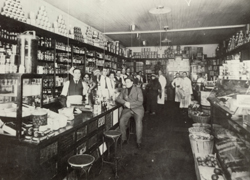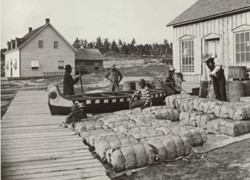The Hudson’s Bay Company in Rat Portage
Lake of the Woods Museum Newsletter
Vol. 14 No. 2 – Spring 2004
by the Hudson’s Bay Company Archives
1836. That is the earliest reference to a trading post near the site known as Portage du Rat or the rat carrying place. It seems likely that the post was built to replace the Dalles post, which closed in 1836.
The Council of the Northern Department of Rupert’s Land appointed Donald McKenzie to take charge of the Rat Portage post for 1837-1838. Business there that winter was prosperous, for in March, two men and a guide were sent to Fort Frances with a request for more trading goods. The Rat Portage men returned pretty well loaded with strouds, blankets, gunpowder, etc., etc. for the trade…

McKenzie was, on and off, in charge of the Rat Portage post until 1850, when he retired to the Red River Settlement. The Major, as he was known, struggled with the trade in Rat Portage. Nicol Finlayson, who was in charge of the Lac la Pluie district reported that … The poor Major’s men complain much, not of himself, but the wife; and I believe if she did not meddle so much with his affairs he would be more popular than he is; he is living in Clover this winter having made an excellent fishing, and it was so late in the season that the fish are all fresh…
On February 1, 1850, William Sinclair, in charge of the Lac la Pluie district, wrote to Sir George Simpson: Not a single word have I heard from Rat Portage since the fall, all that had come to my knowledge through another channel is that the Indians at that Post have been playing truant with the old Major, this is nothing strange in their way…
Donald McKenzie’s son James succeeded him at the Rat Portage post and he was there until 1858, when George McPherson took over.
It was during McPherson’s tenure that the post was moved from the island to mainland. The post was built on what became Main Street of the town of Rat Portage (now Kenora).
Captain Huyshe Of The Wolseley Expedition Of 1870 wrote:
“The Hudson’s Bay Company’s post at Rat Portage is but a small affair, three log houses roofed with bark and enclosed by a wooden palisading. The Company maintained thirteen men at this post, but nine of then are employed at small outlying posts in the vicinity. Mr. MacPherson, the official in charge, was most civil and obliging. He is a Scotch half-breed, a quiet, gentlemanly, elderly man, who has received a good education in Montreal. He had been for thirteen years buried alive at this post! It is not a most extraordinary thing, that men of any education can be found to stand a life like that, utterly cut off from the rest of mankind, receiving news from the outside world only once or twice a year, to all intents or purposes dead or sleeping? … I ventured to question Mr. MacPherson on this subject, and he replied simply that he had long since ceased to feel anything of the kind; he had his little farm and his wife and family, and was quite happy and contented… Mr. MacPherson had a few acres of wheat, barley and potatoes, some pigs and cows, and any number of mangy-looking pariah dogs. These dogs are of all sizes and colours, nasty-looking brutes, but very useful. They do all the winter work, galloping for miles over the frozen snow, dragging small sledges.”
McPherson was succeeded by Robert Laurenson, who in 1874 was transferred from Rat Portage to the North West Angle. Peter Sinclair was left in charge at Rat Portage, but on December 15, 1874, Chief Trader A.R. Lillie wrote from Fort Frances to Chief Commissioner at Fort Garry reporting the arrival of Laurenson from North West Angle and Rat Portage…
“Mr. Laurenson brings me the melancholy intelligence of the supposed untimely death of Mr. Peter Sinclair, Post Master Rat Portage (and I think there is very little doubt about it from the facts). The poor man had gone from the Fort to bring in the Cattle a little before dark on the evening of the 7th Ultimo and never returned; nor, has any trace of him been discovered in any respect since that date, though a search was made for him in every direction that same night and guns fired till morning and search for him was continued by the servants of the post and the Indians for several days after; but neither track nor trace did they find. It is therefore the opinion of all that the night being very dark and stormy he must have stumbled over the rocks (with which that place abounds) into the lake or river and drowned. The sad event was at once communicated to Mr. Laurenson at North West Angle and he forthwith proceeded to Rat Portage and prosecuted a further search but to no effect.”
A young Louis Kittson filled in at Rat Portage until Captain Gilbert Hackland came to take charge for the remainder of 1874-1875. Laurenson was back at Rat Portage for a few years but left the Company at the end of May 1877 and his place was taken by Charles S. Crowe and later A.R. Lillie.
When Laurenson Left The Employ Of The Company, He Went Into Business For Himself, Focusing On Retail Trade For The Railway Work, But Also Buying Furs On The Side. The Hudson’s Bay Company Realized That They Were Facing Competition. Lillie Wrote To The Chief Commissioner In November 1879
“… there are now on the Town Plot at this place some half dozen stores all of which are well stocked with goods of every description and apparently doing a good cash business, and I fear all of them will buy furs when they get a chance of doing so, but I shall use my utmost endeavours to prevent as many skins as possible going their way…Our new store is now about finished and I regret that we have not a better assortment of goods to put into it, so that we might at least come in for a share of the cash in circulation…”
When Chief Trader Alexander Matheson took charge at Rat Portage in 1880, the need for a change in the Company’s trade was expressed in this letter to the Company’s secretary in London from the Company’s Land Commissioner in Winnipeg:
“We are of the opinion that the Premises of the Fur Trade at Rat Portage had better be remodelled to adapt them to the general business that is springing up at that place in addition to the Fur Trade owing to the process of the Railway Works and the establishment of Mills in its vicinity.”
In the early months of 1881, the Company moved into another building which was subsequently damaged by fire in 1886 when the adjacent Rideout House burned down. A stone building was constructed that year to house the Company shop (the building is still standing; it is the recent site of Donny B’s).
Inspecting Officers P.W. Bell Ad E.K. Beeston Reported On The General Conditions In Rat Portage In 1886
“Owing to the depression in Trade in the Town, arising from many causes, among which are the unsettled dispute between the Provincial and Dominion Governments as to the Territory, the too great number of stores, the shutting down of some of the Lumber Mills and Mines, the business of the Company’s Sale Shop is a very difficult one to conduct… the competition for the business done is very keen. In spite of the difficulty of carrying on the Fur trade at this Post, where there are so many Buyers, in many cases offering cash according to the fluctuations of the market, the Fur Trade shews a gain…”
They noted as well that there were outposts in Keewatin, Whitefish Bay, North West Angle, White Dog, Wabigoon, Hungry Hall, Eagle Lake, and Shoal Lake.
Alexander Matheson was succeeded by J.R. Bunn in 1892. By that time it appears that the Company’s Rat Portage business had moved from the fur trade to the saleshops. It was the Company’s hope that with the growth of industries like mining and lumbering, there could be a successful and prosperous business done here.
But reports written following 1900, indicate that the Company’s business was on a steady decline.
In 1902
Rat Portage suffered considerably from sundry fires in which the two principal hotels were completely destroyed, together with other buildings on the Main Street. Up to the time of taking Inventory no steps had been taken to rebuild and the transient trade was considerably diminished on this account, whilst mining operations during the entire year have been very limited…
In 1904-05, This Report
The Saleshop in Kenora, being the newly registered name for the town formerly known as Rat Portage, shows a decrease in total Sales… due to a less amount of business being derived from Railway construction and Survey parties, and the closing out at 31st May 1904 of two small unremunerative trading Posts formerly conducted as an adjunct to the Saleshop…

In 1911, H.E. Burbidge, The Company’s Stores Commissioner Reported
“… the trade conditions at Kenora are anything but satisfactory. Following the completion of extensive Railway construction in Kenora district about two years ago there has been a severe business depression and a number of stores have ceased to carry on business…”
Burbidge Again Wrote In 1916
“… Kenora depends largely on its summer visitors, and has felt the advent of hard times very severely this last year. Also, it is a divisional point on the Canadian Pacific Railway’s system, and with the heavy reduction in the number of employees consequent upon the diminishing volume of traffic, the permanent population of the town has dwindled…”
Kenora trade was again disappointing in 1917, and in the spring of 1918 the decision was made to close the store permanently. With the completion of the Grand Trunk Pacific and Canadian Pacific Railway lines, business had been very unsatisfactory and no improvement was expected.
Did you know?
The Lake of the Woods is a remnant of glacial Lake Agassiz and contains 14 542 islands. The underlying Precambrian bedrock is one of the oldest geological formations on earth.
